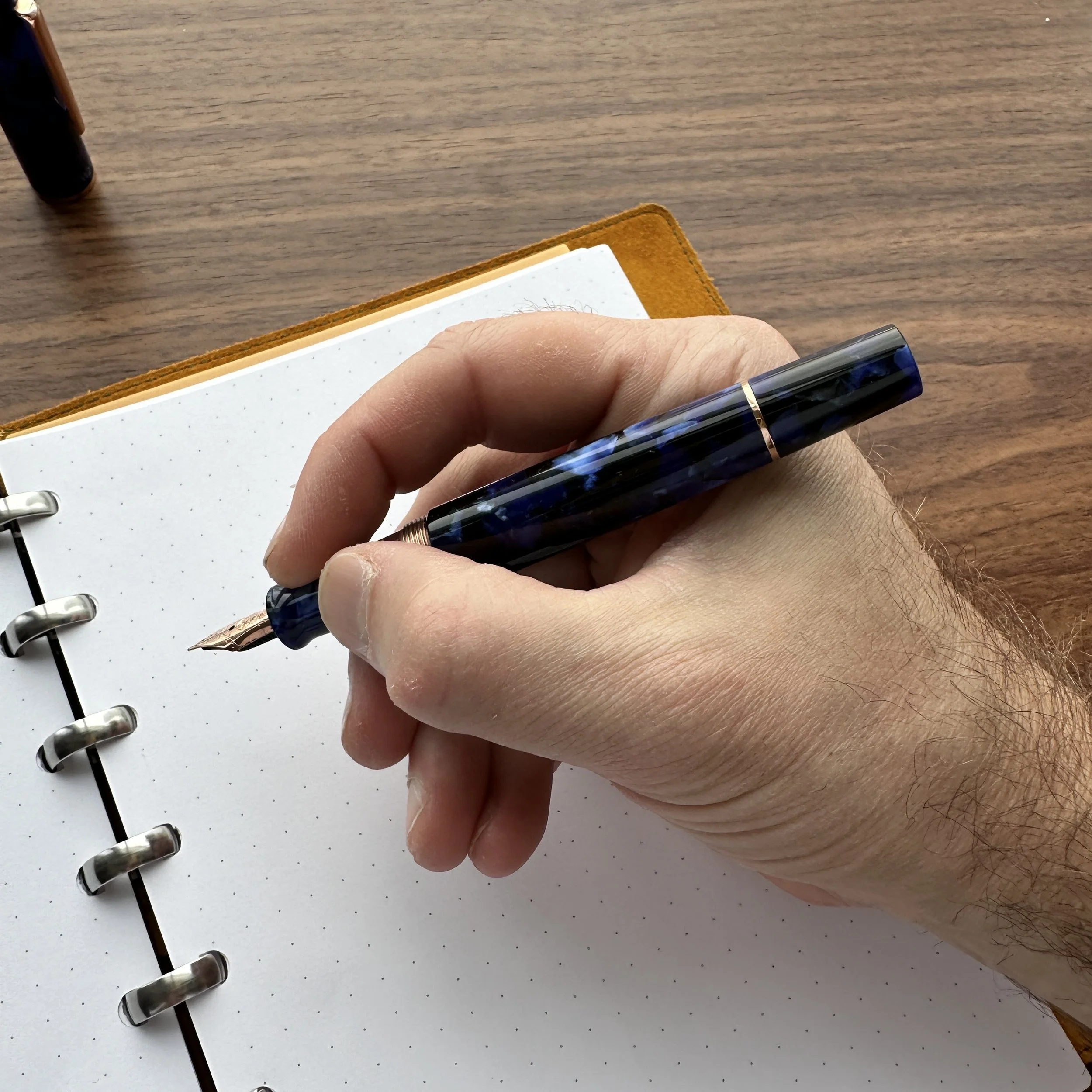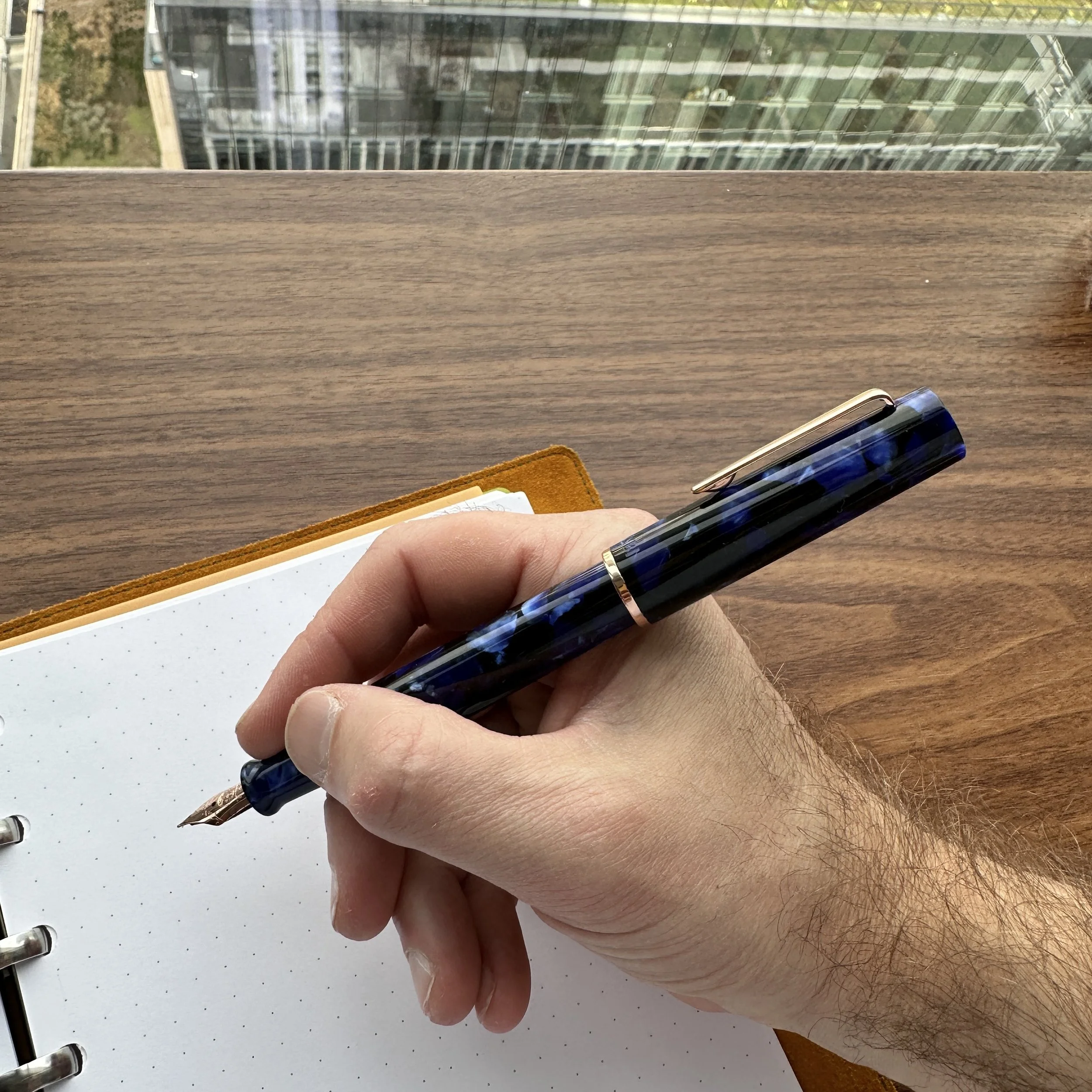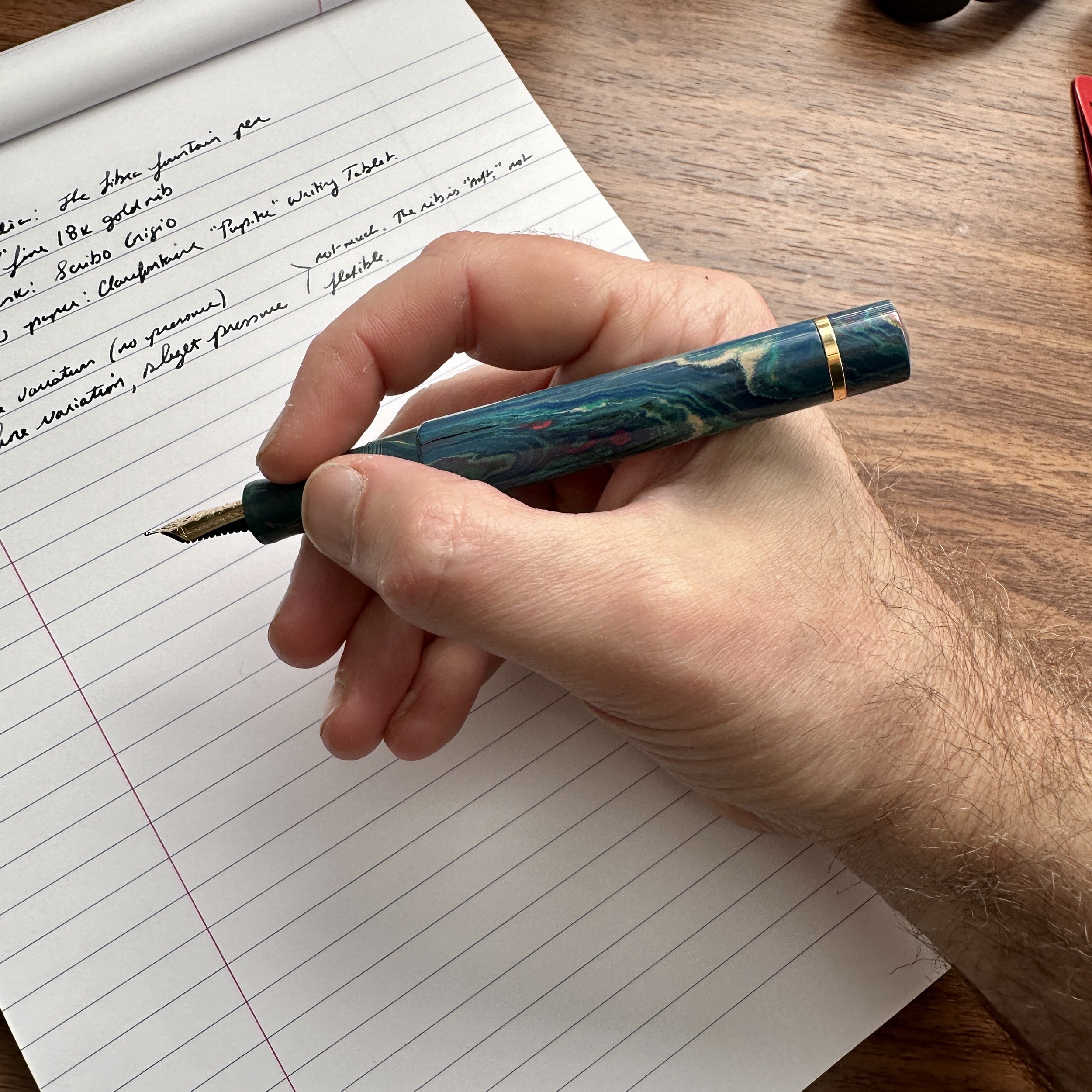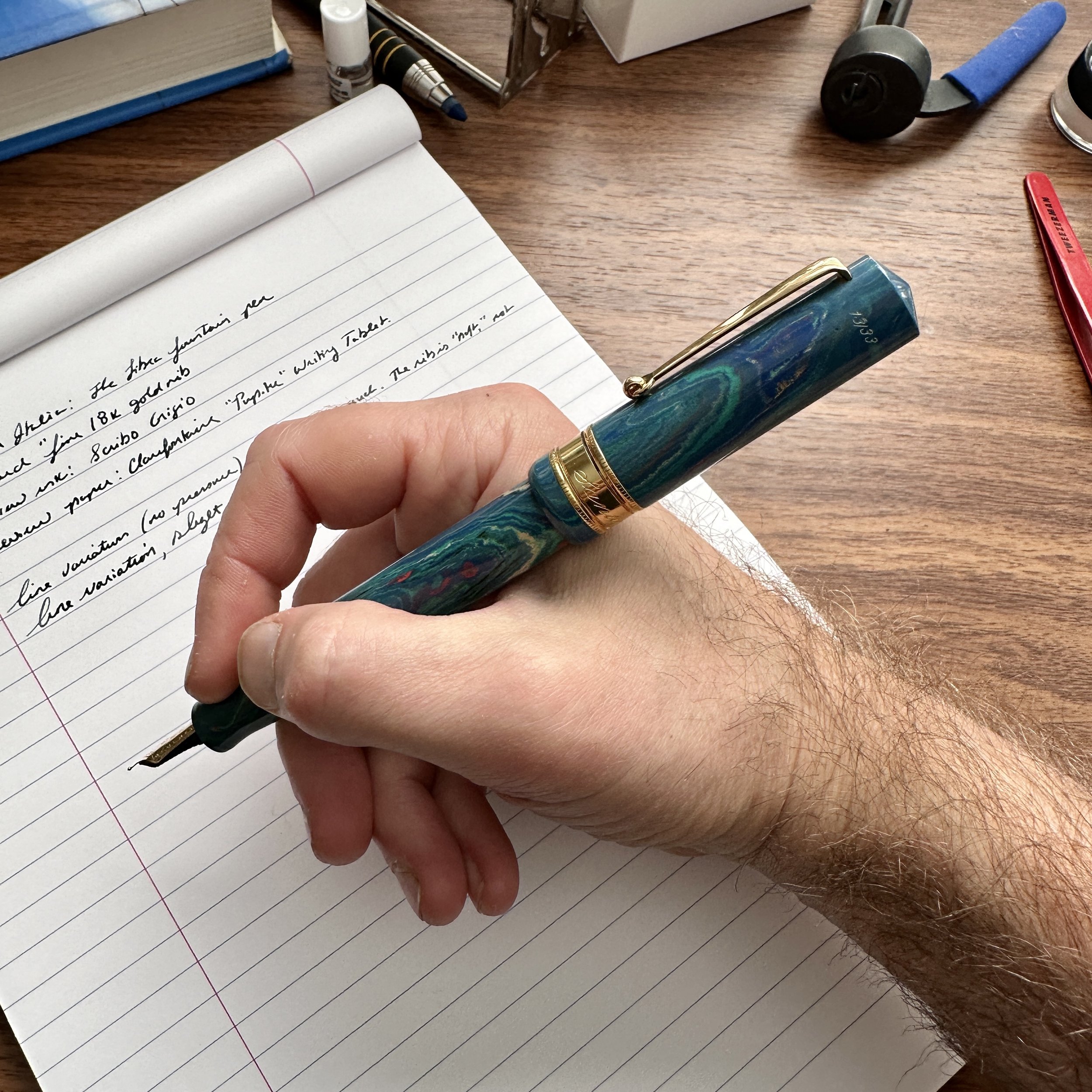TWSBI rarely adds new pens to their lineup, with the last completely new shape being the TWSBI Swipe. While some might view the recently released TWSBI Kai as a “new addition”, that’s not entirely true: TWSBI previously released limited runs of similar acrylic piston fillers, spaced approximately 2-3 years apart. The first, the TWSBI “Aurora”, was a green pen in short supply, while the second, the TWSBI “Draco”, received a broader release and more people were able to get their hands on them. The Kai seems to be more widely available, though TWSBI continues to describe it as a limited release. That’s not unusual - most TWSBI editions such as the special edition ECO and Diamond 580 fountain pens are made for a period of time and then retired, but the standard (i.e., clear acrylic, black/white, rose gold) versions remain available. What is unusual is the absence of this otherwise unnamed acrylic piston filler from the regular lineup. It’s solely a limited edition pen.
The TWSBI logo is subtly engraved on the finial, as opposed to the inlaid red plastic logo.
I Would Love to See More Regular Higher-End TWSBI Fountain Pens
I’ve really enjoyed working with the TWSBI Kai for the past couple of weeks. Having missed out on the Draco, I made sure to reserve a Kai for myself as part of my larger order for the shop. The pen has not disappointed - the Kai both looks great and serves as a comfortable workhorse with a shape somewhat reminiscent of the Aurora Optima. The Kai shares the same streamlined flat-top profile - an all-time favorite - though the Kai does not post as deeply as the Optima. Fortunately, like most TWSBI piston fillers, it’s also lightweight and well-balanced even unposted.
No surprises here. The Kai uses the same nib as the Diamond 580, which offers the same reliable writing experience I’ve come to expect.
There’s nothing particularly remarkable or unexpected about the writing experience itself - the Kai is classic TWSBI, and uses the same reliable nib as found in the Diamond 580 series. (The Kai doesn’t use the interchangeable nib units, however, as the nib is friction-fit.) What does make this pen stand out, however, are the visuals. I’ve always admired this series of TWSBI releases, and remain puzzled by their irregularity. The Kai is a beautiful pen, featuring a deep indigo blue-flecked acrylic trimmed in rose gold, which TWSBI always does extremely well. The material has a lot of depth, and I’d venture that the pen looks more expensive than its price point would suggest.
As a more general matter, I’ve noticed that TWSBI’s nib consistency has improved in recent years, and that there is more delineation between the sizes. This EF nib actually writes an extra-fine line. Not a fine (or even a medium like some I’ve used in the past), but a true extra-fine.
A few design touches distinguish the Kai from other TWSBIs. First, there’s no red anywhere on the pen. Most TWSBI models feature the signature red TWSBI finial on the cap, yet the logo on the Kai is engraved. I go back and forth on whether I would prefer the Kai with a pop of red, but at the end of the day feel that TWSBI made the right choice by not adding additional plastic to a higher-end offering.
Second, the barrel and inner cap feature metal rose-gold threads, which work smoothly without any grating noise or excess friction. The pen uncaps in two turns, allowing for quick deployment, and the threads sit high enough on the barrel (behind the ink window) that they don’t interfere with my grip. If I had one critique of the design, it would be the posting issue I mentioned above. Flat-top pens such as this one - including favorites like the Aurora Optima and Sailor Pro Gear - seem especially suited for posting. Could TWSBI have slimmed down the barrel just a bit more? Perhaps, but apart from the Diamond Mini and Vac Mini, TWSBI has never designed pens that post well, and the fact that the Kai is no exception doesn’t surprise me. (Note: As shown above, like most TWSBIs, the Kai does technically post, just not deeply, and I find it uncomfortably long and awkward to use this way.)
The metal threads just work here. I find the pop of rose gold on the barrel visually interesting.
So Where Exactly Does the Kai Fit into TWSBI’s Lineup?
I would organize the current TWSBI fountain pen lineup as follows:
Entry Level Pens: TWSBI Go ($18.99); Swipe ($26.99); and TWSBI ECO and ECO-T “Standard” ($32.99)
Mid-Range: TWSBI ECO and ECO-T “Special Trim” editions ($49.99 - $70), TWSBI Diamond 580 and Diamond Mini “Standard” ($50-$65); Vac Mini ($60); Vac700R ($65)
Upper Mid-Range: TWSBI Diamond 580 Rose Gold Editions ($80-$85); Vac700R Iris ($80); Precision ($80)
“High End”: TWSBI Kai, Aurora, and Draco Special Editions ($130 - the Draco and Aurora were actually priced higher at $150(?))
As you can see, that’s a pretty compressed range in terms of price point, with even the “high-end” TWSBI pens not breaking the bank. TWSBI is known for never having targeted the gold-nib market or the “luxury” price point, hence their fairly dominant market position in the sub-$100 fountain pen segment. I would like to see the Kai, or some version thereof, become a permanent offering. Even if there’s no standard version, having one special or limited pen always available would round out TWSBI’s lineup and expand their appeal beyond those who enjoy the demonstrators.
One of these things is not like the others.
Takeaways and Where to Buy
I’m enjoying the TWSBI Kai, and I’m glad I picked one up to compensate for missing out on the Draco (though I’d love to see them bring back that burgundy and black combination). While the Kai is a bit more expensive than other TWSBI piston-fillers, the price is consistent with higher-end pens from brands like Opus 88 and Nahvalur, and maybe even a little lower. It would be great to be able to recommend the Kai as a workhorse fountain pen to those seeking a slightly more traditional design than the Diamond 580 or Vac700R. There’s certainly demand - the Kai has sold well, and I’ve seen Dracos selling on the secondary market for hundreds of dollars!
The Kai is a classy pen that wouldn’t look out of place next to pens twice the price.
As TWSBI retailers, we carry the TWSBI Kai in the T.G.S. Curated Shop, and have a selection of these pens currently in stock. It’s unclear when the next run will be made available after these sell out, though I seem to recall that the Draco stuck around for six months or so. The Kai is priced at $130.00, which is the top of the TWSBI range, though in line with the price point of many other similarly-styled resin piston fillers.
Further Reading on twsbi
I’ve managed to review most TWSBI pens, with a couple exceptions, over the years. If you’d like to review previous content, please check out the Fountain Pen Review Archive, which is organized by brand, including TWSBI.
The Gentleman Stationer is supported by purchases from the T.G.S. Curated Shop and pledges via the T.G.S. Patreon Program. This post does not contain paid advertising or third-party affiliate links.




